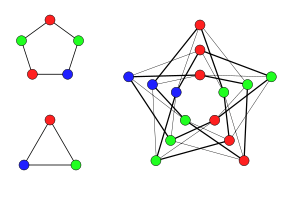Hedetniemi's conjecture

In graph theory, Hedetniemi's conjecture, named after Stephen T. Hedetniemi, concerns the connection between graph coloring and the tensor product of graphs. This conjecture states that
- χ(G × H) = min {χ(G), χ(H)}.
Here χ(G) denotes the chromatic number of an undirected finite graph G. An inequality in one direction is easy: if G is k-colored, one can k-color G × H by using the same coloring for each copy of G in the product, so χ(G × H) ≤ χ(G). For the same reason χ(G × H) ≤ χ(H); therefore, χ(G × H) ≤ min {χ(G), χ(H)}. Thus, Hedetniemi's conjecture amounts to the assertion that tensor products can't be colored with an unexpectedly small number of colors.
Hedetniemi formulated his conjecture in 1966 based on the inequality described above. Hedetniemi's conjecture has also been called the Lovász-Hedetniemi conjecture (Zhu 1998). It cannot be generalized to infinite graphs: Hajnal (1985) gave an example of two infinite graphs, each requiring an uncountable number of colors, such that their product can be colored with only countably many colors. Rinot (2013) proved that in the constructible universe, for every infinite cardinal  , there exist a pair of graphs of chromatic number greater than
, there exist a pair of graphs of chromatic number greater than  , such that their product can still be colored with only countably many colors.
, such that their product can still be colored with only countably many colors.
Example
Suppose that G and H are both cycle graphs Cm and Cn. Then the edges of G × H can be grouped into cycles with length equal to the least common multiple of m and n. Thus, if both G and H have an odd number of vertices and therefore require three colors, the product G × H will contain odd cycles and will also require three colors.
Special cases
Clearly, any graph with a nonempty set of edges requires two colors; therefore, the conjecture is true whenever G or H is bipartite. It is also true when G or H is 3-colorable, for if both G and H contain an odd cycle then so does G × H. In the remaining cases, both factors of the tensor product require four or more colors. When both factors are 4-chromatic, El-Zahar & Sauer (1985) showed that their tensor product also requires four colors; therefore, Hedetniemi's conjecture is true for this case as well.
Related problems
A similar equality for the cartesian product of graphs was proven by Sabidussi (1957) and rediscovered several times afterwards. Häggkvist et al. (1988) view graph coloring categorically, as a homomorphism from a graph to a complete graph, and consider similar problems for generalizations of graph coloring involving homomorphisms to incomplete graphs. Duffus, Sands & Woodrow (1985) introduced two stronger conjectures involving unique colorability.
References
- Primary sources
- Duffus, D.; Sands, B.; Woodrow, R. E. (1985), "On the chromatic number of the product of graphs", Journal of Graph Theory 9 (4): 487–495, doi:10.1002/jgt.3190090409, MR 0890239.
- El-Zahar, M.; Sauer, N. (1985), "The chromatic number of the product of two 4-chromatic graphs is 4", Combinatorica 5 (2): 121–126, doi:10.1007/BF02579374, MR 0815577.
- Häggkvist, R.; Hell, P.; Miller, D. J.; Neumann Lara, V. (1988), "On multiplicative graphs and the product conjecture", Combinatorica 8 (1): 63–74, doi:10.1007/BF02122553, MR 0951994.
- Hajnal, A. (1985), "The chromatic number of the product of two ℵ1 chromatic graphs can be countable", Combinatorica 5 (2): 137–140, doi:10.1007/BF02579376, MR 0815579.
- Hedetniemi, S. (1966), Homomorphisms of graphs and automata, Technical Report 03105-44-T, University of Michigan.
- Rinot, Assaf (2013), Hedetniemi's conjecture for uncountable graphs, arXiv:1307.6841.
- Sabidussi, G. (1957), "Graphs with given group and given graph-theoretical properties", Canadian Journal of Mathematics 9: 515–525, doi:10.4153/CJM-1957-060-7, MR 0094810.
- Surveys and secondary sources
- Imrich, Wilfried; Klavžar, Sandi (2000), Product Graphs: Structure and Recognition, Wiley, ISBN 0-471-37039-8
- Klavžar, Sandi (1996), "Coloring graph products: a survey", Discrete Mathematics 155 (1–3): 135–145, doi:10.1016/0012-365X(94)00377-U, MR 1401366.
- Sauer, N. (2001), "Hedetniemi's conjecture: a survey", Discrete Mathematics 229 (1–3): 261–292, doi:10.1016/S0012-365X(00)00213-2, MR 1815610.
- Zhu, Xuding (1998), "A survey on Hedetniemi's conjecture", Taiwanese J. Math. 2 (1): 1–24, MR 1609464.